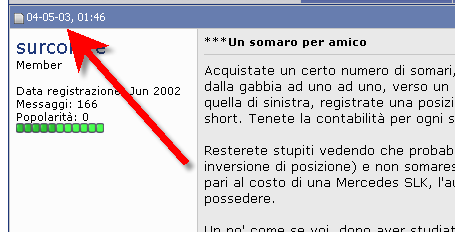***Un somaro per amico
Acquistate un certo numero di somari, 100 diciamo, numerateli e ogni pomeriggio verso le 1730 fateli uscire dalla gabbia ad uno ad uno, verso un tavolo su cui avrete sistemato due carote. Se il somaro mangia prima quella di sinistra, registrate una posizione long sul FIB, se acchiappa prima quella a destra una posizione short. Tenete la contabilità per ogni somaro e dopo due anni verificate le varie performance.
Resterete stupiti vedendo che probabilmente, pur tenendo conto di costi di transazione umani (20 tick per inversione di posizione) e non somareschi, oltre una decina di somari saranno riusciti ad avere un profitto pari al costo di una Mercedes SLK, l'automobile meno pretenziosa che un trader che si rispetti dovrebbe possedere.
Un po' come se voi, dopo aver studiato una decina di strategie sui due anni di dati del FIB, incappate finalmente in quella buona, che guadagna.
Sarà perchè siete stati bravi, o come capita ai somari, semplicemente perchè dato un grande nunero di strategie provate è INEVITABILE che per pura chance una si adatti magicamente ai dati?
Se odiate i ragli e le carote, per fare questo gioco usate l'indicatore per tradestation a piè di questo post: levelGain fissa la soglia di guadagno in punti-FIB, nDonkey il numero di somari con cui fare il gioco, mentre lo storico del FIb eod lo pescate free-of-charge da borsatech.com : il numero di somari vincenti vi apparirà a piè di chart.
Questo esperimento aiuta a:
1. considerare con terrore il probelma dell'overfitting
2. considerare con tra il sospettoso e l'umoristico analisi su serie storiche troppo corte
3. capire che dati 100.000 trader americani è inevitabile che per pura fortuna alcuni inanellino delle performance da capogiro per anni e anni.
4. considerare con sospetto i pochi trader vincenti del punto 3, se improvvisamente dismettono il trading per fare conferenze o scrivere libri.
5. avere consapevolezza che le serie storiche finanziarie sono più efficienti di quanto si possa credere.
Questo l'indicatore in easylanguage:
{********************************
type: indicator
name: nDonkey
author: surcontre, 2003
********************************** }
inputs: levelGain(7000),nDonkey(100);
vars:sumD(0),y(0),j(0),k(0),z(0),n(0),max(0),cap(0),f(0);
arrays: x[3000](0);
n=n+1;
if n>1 then x[n]=c-c[1];
if lastbaronchart then begin
for y=1 to nDonkey begin
cap=0;
f=1;
for k=2 to n begin
cap=cap+x[k]*f;
z=random(1);
if f=-1 and z>0.5 then begin
f=1;
cap=cap-20;
end;
if f=1 and z<0.5 then begin
f=-1;
cap=cap-20;
end;
end;
if cap>levelGain then sumD=sumD+1;
end;
plot1(sumD,"");
end;
Happy trading
Acquistate un certo numero di somari, 100 diciamo, numerateli e ogni pomeriggio verso le 1730 fateli uscire dalla gabbia ad uno ad uno, verso un tavolo su cui avrete sistemato due carote. Se il somaro mangia prima quella di sinistra, registrate una posizione long sul FIB, se acchiappa prima quella a destra una posizione short. Tenete la contabilità per ogni somaro e dopo due anni verificate le varie performance.
Resterete stupiti vedendo che probabilmente, pur tenendo conto di costi di transazione umani (20 tick per inversione di posizione) e non somareschi, oltre una decina di somari saranno riusciti ad avere un profitto pari al costo di una Mercedes SLK, l'automobile meno pretenziosa che un trader che si rispetti dovrebbe possedere.
Un po' come se voi, dopo aver studiato una decina di strategie sui due anni di dati del FIB, incappate finalmente in quella buona, che guadagna.
Sarà perchè siete stati bravi, o come capita ai somari, semplicemente perchè dato un grande nunero di strategie provate è INEVITABILE che per pura chance una si adatti magicamente ai dati?
Se odiate i ragli e le carote, per fare questo gioco usate l'indicatore per tradestation a piè di questo post: levelGain fissa la soglia di guadagno in punti-FIB, nDonkey il numero di somari con cui fare il gioco, mentre lo storico del FIb eod lo pescate free-of-charge da borsatech.com : il numero di somari vincenti vi apparirà a piè di chart.
Questo esperimento aiuta a:
1. considerare con terrore il probelma dell'overfitting
2. considerare con tra il sospettoso e l'umoristico analisi su serie storiche troppo corte
3. capire che dati 100.000 trader americani è inevitabile che per pura fortuna alcuni inanellino delle performance da capogiro per anni e anni.
4. considerare con sospetto i pochi trader vincenti del punto 3, se improvvisamente dismettono il trading per fare conferenze o scrivere libri.
5. avere consapevolezza che le serie storiche finanziarie sono più efficienti di quanto si possa credere.
Questo l'indicatore in easylanguage:
{********************************
type: indicator
name: nDonkey
author: surcontre, 2003
********************************** }
inputs: levelGain(7000),nDonkey(100);
vars:sumD(0),y(0),j(0),k(0),z(0),n(0),max(0),cap(0),f(0);
arrays: x[3000](0);
n=n+1;
if n>1 then x[n]=c-c[1];
if lastbaronchart then begin
for y=1 to nDonkey begin
cap=0;
f=1;
for k=2 to n begin
cap=cap+x[k]*f;
z=random(1);
if f=-1 and z>0.5 then begin
f=1;
cap=cap-20;
end;
if f=1 and z<0.5 then begin
f=-1;
cap=cap-20;
end;
end;
if cap>levelGain then sumD=sumD+1;
end;
plot1(sumD,"");
end;
Happy trading

 I principali indici azionari hanno vissuto una settimana turbolenta, caratterizzata dalla riunione della Fed, dai dati macro importanti e dagli utili societari di alcune big tech Usa. Mercoledì scorso la Fed ha confermato i tassi di interesse e ha sostanzialmente escluso un aumento. Tuttavia, Powell e colleghi potrebbero lasciare il costo del denaro su livelli restrittivi in mancanza di progressi sul fronte dei prezzi. Inoltre, i dati di oggi sul mercato del lavoro Usa hanno mostrato dei segnali di raffreddamento. Per continuare a leggere visita il
I principali indici azionari hanno vissuto una settimana turbolenta, caratterizzata dalla riunione della Fed, dai dati macro importanti e dagli utili societari di alcune big tech Usa. Mercoledì scorso la Fed ha confermato i tassi di interesse e ha sostanzialmente escluso un aumento. Tuttavia, Powell e colleghi potrebbero lasciare il costo del denaro su livelli restrittivi in mancanza di progressi sul fronte dei prezzi. Inoltre, i dati di oggi sul mercato del lavoro Usa hanno mostrato dei segnali di raffreddamento. Per continuare a leggere visita il 
